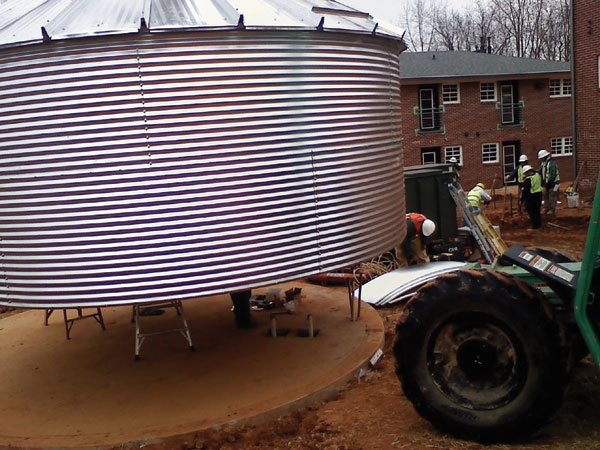Harvesting Rain: System Design for Strategic Rainwater Capture
Rainwater Systems: Calculating Resources
Rainwater collection should be thought of as a whole, not a collection of parts. Rainwater systems can be as simple as an above ground rain barrel attached to a downspout or as complex as a large underground storage cistern with connections and treatment options. The project budget, the end use for the rainwater, the demands of the project, the climate and the design aesthetics are some of the factors that will determine the type of rainwater system chosen by the project design professional or civil engineer. In addition, communities are developing new water regulations that may also affect the size and type of rainwater collection systems. Many western states are grappling with the issue of water rights. Unlike states with riparian water rights, many of the states that follow prior appropriation laws specifically prohibit the collection of rainwater. Recent legislation permitting limited capture in Colorado and mandating the use of rainwater in Tucson, Arizona are signs of new attitudes toward managing water resources.
Manufacturers of rainwater systems will assist design professionals as they set goals for rainwater collection and storage. How do you want to use rainwater? How much water can you collect by design? How much water do you need for your project? When sizing for rainwater capture, the design goal, whenever feasible, is to achieve water balance so that the volume of water collected equals or exceeds the volume of water used.
An optimal balanced rainwater system will lose the least amount of water to overflow during the wettest times of the year while maintaining some water in storage during the driest times of the year. The design must always take into account the budget and physical limitations of the site. Although it is possible to capture every drop of water from a collection surface, it may be either impractical or unnecessary to do so.
The National Weather Service Forecast Office5 publishes the annual amount of rain for communities. The American Rainwater Catchment Systems Association (ARCSA) also publishes detailed analysis on rainwater capture. Annual rainfall as well as its monthly distribution is important to consider when sizing a storage tank. Larger storage tanks are required in hot humid climates where rainfall is seasonal and in hot dry climates with long periods between storms. Smaller storage tanks may be adequate in a city like Portland, Oregon where there are frequent storms and steady showers. Regardless of the pitch, the shape or the complexity of the roof surface, the overall footprint of the building from eave-to-eave determines the catchment area. Approximately 0.62 gallons per square foot of collection surface per inch of rainfall is collected when it rains. The storage area for harvested water will approximately equal the catchment area (sq. ft.) X depth (in.) X 0.623. Proper maintenance, undersized or clogged gutters will also reduce rainfall collection.
Chris Kid's, Atlanta, GA |
Chris Kid's is a nonprofit organization in Atlanta, Georgia that provides assisted housing for young adults. They installed a 19,000-gallon above-ground storage tank with a 6,000-gallon below ground sump to collect both roof water and surface water for irrigation. |
 |
Photo courtesy of BRAE Above-ground storage tank installation. |










